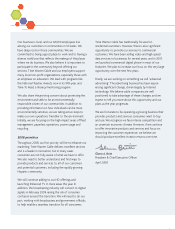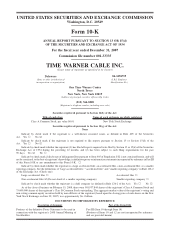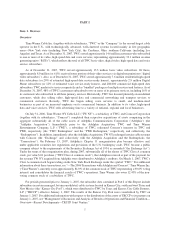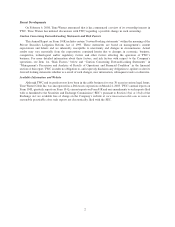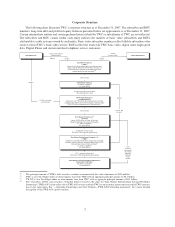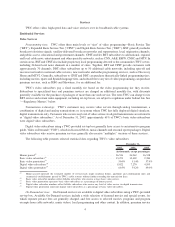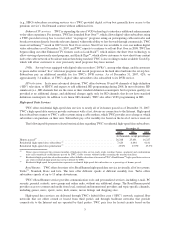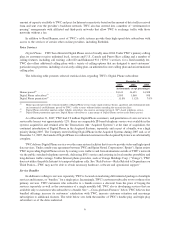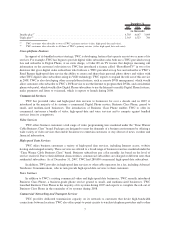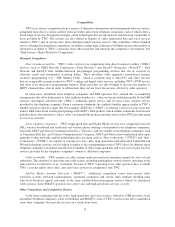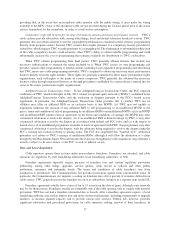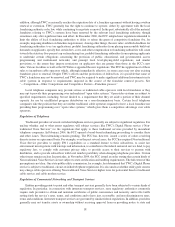Time Warner Cable 2007 Annual Report Download - page 14
Download and view the complete annual report
Please find page 14 of the 2007 Time Warner Cable annual report below. You can navigate through the pages in the report by either clicking on the pages listed below, or by using the keyword search tool below to find specific information within the annual report.Customer Care
TWC believes that superior customer care can help increase customer satisfaction, promote customer loyalty
and lasting customer relationships and increase the penetration of its services. TWC’s customer care strategy is
focused on three key components, including:
•Ease of Access—seeking to minimize telephone wait times for TWC customers;
•Quality Infrastructure—maintaining tools to measure and manage TWC’s network infrastructure and
customer premise equipment to resolve customer issues on the first visit to customers’ homes and
businesses; and
•Training—developing front-line employees able to handle both service and sales.
In order to improve the measurement and management of TWC’s network infrastructure and customer premise
equipment, TWC expects to roll out in 2008 engineering tools that will give installation technicians and customer
care representatives access to real-time information about the operating conditions of the equipment in its
customers’ homes.
Technology
Cable Systems
TWC’s cable systems employ a flexible and extensible HFC network. TWC transmits signals on these systems
via laser-fed fiber optic cable from origination points known as “headends” and “hubs” to a group of distribution
“nodes,” and uses coaxial cable to deliver these signals from the individual nodes to the homes they serve. TWC
pioneered this architecture and received an Emmy award in 1994 for its HFC development efforts. HFC architecture
allows the delivery of two-way video and broadband transmissions, which is essential to providing advanced video
services, like VOD, Road Runner high-speed data service and Digital Phone.
As of December 31, 2007, according to TWC’s estimates, approximately 98% of all homes passed by TWC’s
cable systems were served by plant that had been upgraded to provide at least 750MHz of capacity. Carriage of
programming through analog transmissions (approximately 70 channels per system) uses about two-thirds of a
typical system’s capacity, leaving the remaining capacity for digital video, high-speed data and voice services.
Digital signals, including video, high-speed data and voice signals, can be carried more efficiently than analog
signals. Generally 10 to 12 digital channels or their equivalent can be carried using the same amount of capacity
required to carry just one analog channel.
TWC believes that its network architecture is sufficiently flexible and extensible to support its current
requirements. However, in order for TWC to continue to innovate and deliver new services to its customers, as well
as meet its competitive needs, TWC anticipates that it will need to use more efficiently the bandwidth available to its
systems over the next few years. TWC believes that this can be achieved largely without costly upgrades. For
example, to accommodate increasing numbers of HDTV channels and other demands for greater capacity in its
network, TWC is deploying a technology known as switched digital video (“SDV”). This expansion of network
capacity relies on switching equipment in TWC’s headends and hubs and, as necessary, segmenting its plant to
ensure that switches and lasers are shared among fewer households. By using SDV, only those channels that are
being watched within a given grouping of households are transmitted to those households. Since it is generally the
case that not all channels are being watched at all times by a given group of households, this frees up capacity that
can then be made available for other uses. As a result of this process, capacity is made available for new services,
including HDTV channels. As of December 31, 2007, over 1.4 million (or 18%) of digital video subscribers
received some portion of their video service via SDV technology. TWC expects to continue to deploy SDV
technology during 2008.
Set-top Boxes
Each of TWC’s cable systems uses one of two “conditional access” systems to secure signals from
unauthorized receipt, the intellectual property rights to which are controlled by set-top box manufacturers. In
part as a result of the proprietary nature of these conditional access systems, TWC currently purchases set-top boxes
9


